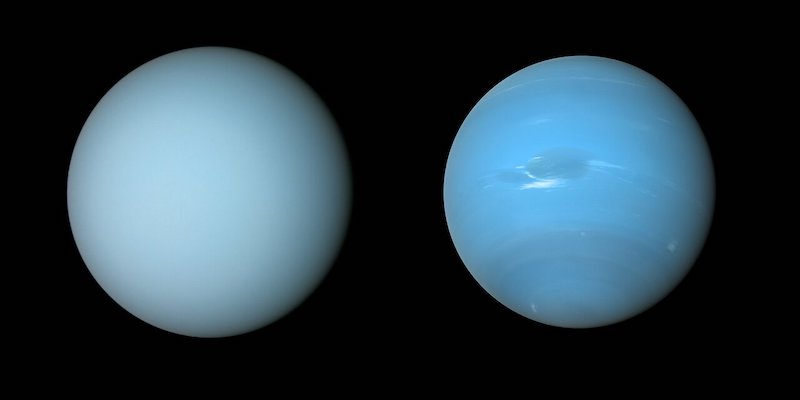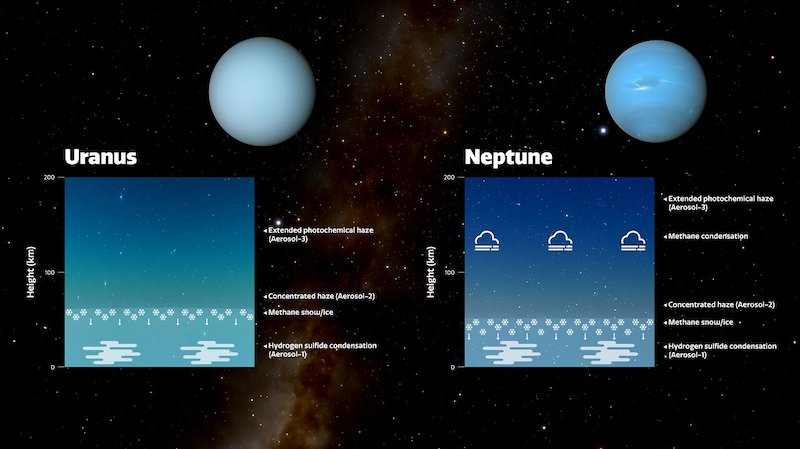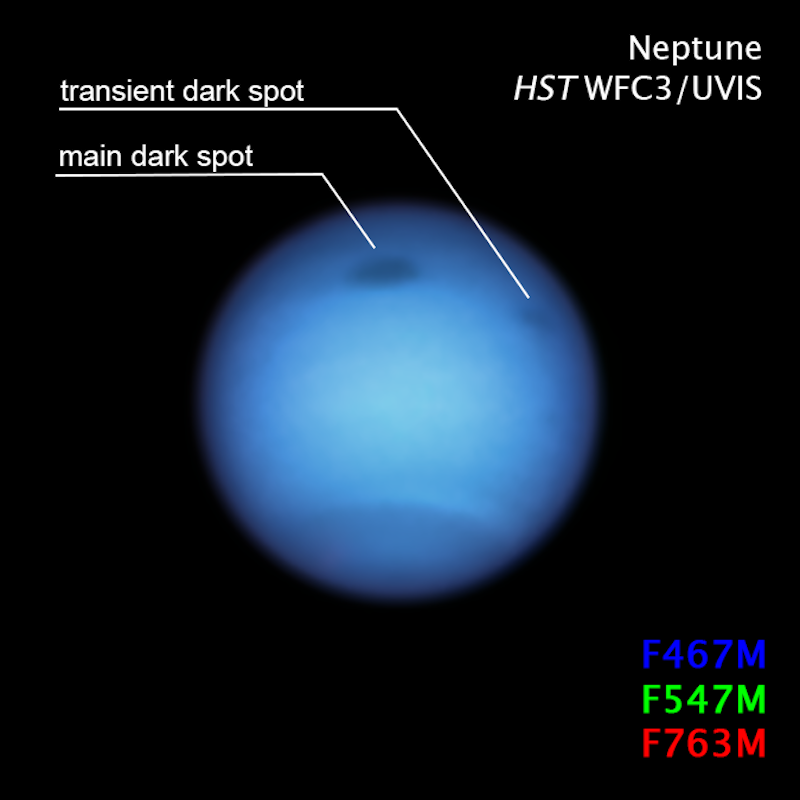
We think of Uranus and Neptune as being similar worlds in the far outer solar system. Both are ice giants, and they’re similar in size and mass. They have similar atmospheric compositions. But – in the image above – see how they’re different colors? Neptune (right) is a deeper blue color than Uranus, which is paler and more of a cyan hue. Scientists have long been puzzled … why the color difference? Then on May 31, 2022, an international team of researchers announced a simple explanation: haze.
The researchers published their findings in the peer-reviewed journal JGR Planets on May 23, 2022. A free preprint version is also available on arXiv.
Uranus and Neptune: almost twins
It’s easy to think of Uranus and Neptunes as twins, or at least near-twins. They are almost the same size, with Neptune being just slightly smaller. Uranus, on the other hand, is slightly less massive than Neptune.
Uranus’ atmosphere consists primarily of hydrogen and helium, but it also contains “ices” such as water, ammonia and methane. These ices also make up the planet’s mantle, which surrounds a rocky inner core.
Neptune’s atmosphere is also mostly composed of hydrogen and helium. It also has similar ices. And again like Uranus, its interior is primarily ices and rock.
It’s largely the icy and rocky interiors of Uranus and Neptune that make them distinct from Jupiter and Saturn, as well as size and mass, of course. This is also why they are called ice giants instead of gas giants.
While they are quite similar in many ways, Uranus and Neptune do have differences, too. Unlike Neptune and Earth and most other major planets in our solar system, Uranus doesn’t rotate around an axis that lies nearly perpendicular with respect to the plane of its orbit. Also, the larger moons of Uranus are in stable orbits that are aligned with the tilt of the planet. But Neptune’s largest moon, Triton, circles the planet at a very inclined orbit.
Bright blue and pale blue
If, for the most part, Uranus and Neptune are so similar, then why the difference in color? Why is Neptune a brighter blue while Uranus is paler? According to the new study, the answer is haze.
Both planets have an aerosol haze in their upper atmospheres. On Uranus, however, there is an excess of that haze, which builds up in the planet’s sluggish atmosphere. The haze causes the atmosphere to have a lighter tone than the atmosphere of Neptune. The new study examined multiple layers of the atmospheres of both planets, across a wide range of wavelengths. As lead author Patrick Irwin, Professor of Planetary Physics at Oxford University, explained:
This is the first model to simultaneously fit observations of reflected sunlight from ultraviolet to near-infrared wavelengths.

Three layers of aerosols
In the new study model, there are three layers of aerosols – a suspension of fine droplets or particles in a gas – at different heights. It is the middle layer that primarily affects the color of the atmosphere. That middle layer is thicker on Uranus than on Neptune. In this layer – on both planets – methane ice condenses on the aerosol particles. This creates a kind of “methane snow.”

As described in the paper:
We suggest that methane condenses so rapidly upon these haze particles that it efficiently ‘snows’ out at the base of this layer, falling to lower, warmer levels, where the methane evaporates, releasing the core haze particles to ‘seed’ hydrogen sulfide condensation.
Neptune’s atmosphere is more active and dynamic than Uranus’, so it is better able to churn up the particles and create the snow. In so doing, it dilutes the haze layer and keeps it thinner. Therefore, with less haze, Neptune’s atmosphere appears bluer.
Mike Wong, an astronomer at the University of California, Berkeley, commented:
We hoped that developing this model would help us understand clouds and hazes in the ice giant atmospheres. Explaining the difference in color between Uranus and Neptune was an unexpected bonus!
Observations of Uranus and Neptune in various wavelengths
The two planets were observed in ultraviolet, visible and near-infrared wavelengths (from 0.3 to 2.5 micrometers). The astronomers used the Near-Infrared Integral Field Spectrometer (NIFS) on the Gemini North telescope in Hawaii for the observations. Additional archival data for the study comes from the NASA Infrared Telescope Facility in Hawaii, and the NASA/ESA Hubble Space Telescope.
The NIFS instrument was particularly useful. It provided spectra for every point in its field of view. Spectra are measurements of how bright an object is at different wavelengths. The data told the researchers how reflective the atmospheres of both planets are. This included the full disk of each planet, as seen in telescopes, and a range of near-infrared wavelengths.
According to Martin Still, Gemini Program Officer at the National Science Foundation:
The Gemini observatories continue to deliver new insights into the nature of our planetary neighbors. In this experiment, Gemini North provided a component within a suite of ground- and space-based facilities critical to the detection and characterization of atmospheric hazes.
Neptune’s dark spots explained
The colors of Uranus and Neptune aren’t the only mystery that the new study model explains. Neptune has well-known dark spots – storms – in its atmosphere, analogous to the red and brown spots in Jupiter’s atmosphere. They are present on Uranus also but are less common. Why? The researchers’ results show that the more frequent spots on Neptune can be explained by a darkening of the deepest aerosol layer. This layer is composed of a mixture of hydrogen sulfide ice and particles produced by the interaction of the planets’ atmospheres with sunlight.

Bottom line: A new study shows that Uranus and Neptune are different shades of blue due to a layer of excessive haze on Uranus. This haze makes its atmosphere look a lighter blue than Neptune’s atmosphere.
Source: Hazy blue worlds: A holistic aerosol model for Uranus and Neptune, including Dark Spots











